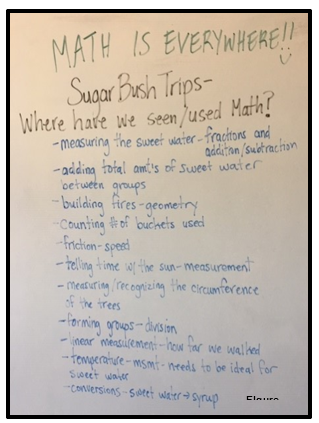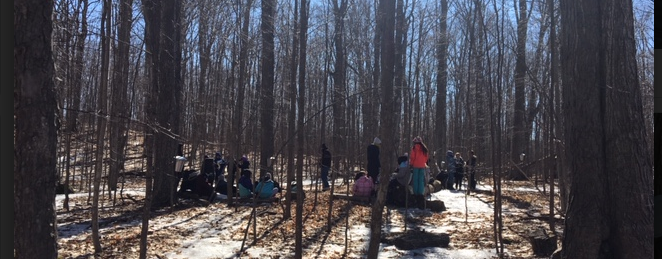Building upon the success of the first year of our inquiry into exploring Indigenous Knowledge and mathematics through an exploration of the harvesting of sweet water and the creation of maple syrup we set forth to deepen our learning again this year.
Working in partnership again with the Credit Valley Métis Council alongside Bill Morrison and his son Kyl, the project this year expanded to include 6 elementary classes from the Dufferin-Peel Catholic DSB’s three most northern schools. Working again with the educators who were on the learning journey in year one, they also brought additional colleagues this year to continue and expand on the learning.
As in year one, our continued focus was to explore the mathematics that was infused in the Indigenous Knowledge being shared with regards to the relationship between the land, the harvesting of sweet water and its transformation into maple syrup.

Having the students out on the land proved again to be the highlight of the project. As they worked through the process of learning about the trees, the tapping process and the harvesting of the sweet water, they also learned about our responsibility to the earth and the importance of a reciprocal relationship with the natural environment. Again one of the highlights was learning that the number of taps was in relation to the number of hugs we could give a tree!
This year there was an increased opportunity as well to further elevate the mathematics that we saw organically present itself in year one’s project. Students applied their understanding of number sense and operations and there were many opportunities where they were asked to take and record measurements, look at patterns and trends, as well as to reflect and predict based upon their learning. It was through these authentic experiences, teachings about the process, and being on the land, that the students began to “organically” see and experience the math. One classes summary of the math they were seeing and doing through the learning can be seen in Figure 1.
 Throughout the program it was evident how Indigenous knowledge and how that knowledge is transferred allowed students to experience and “do” the math as opposed to having it presented abstractly and in isolation. For example, as students began to harvest the sweet water they were having to consider the amounts being collected but their understanding of the quantities became based upon the seeing and feeling of what the full or half filled buckets felt like and associating that with the measurements the were taking with the tools they had created.
Throughout the program it was evident how Indigenous knowledge and how that knowledge is transferred allowed students to experience and “do” the math as opposed to having it presented abstractly and in isolation. For example, as students began to harvest the sweet water they were having to consider the amounts being collected but their understanding of the quantities became based upon the seeing and feeling of what the full or half filled buckets felt like and associating that with the measurements the were taking with the tools they had created.
This year’s journey again reinforced for the team what we began to learn in our first year:
- That Indigenous Knowledge is rich with mathematics and it is about elevating it organically,
- That as much as it is about Indigenous Knowledge we can also learn from Indigenous pedagogies and how that can support our teaching of mathematics in our classrooms,
- That there is much benefit from having students learn on the land.
Chi Miigwetch to all those that joined us on the journey!

